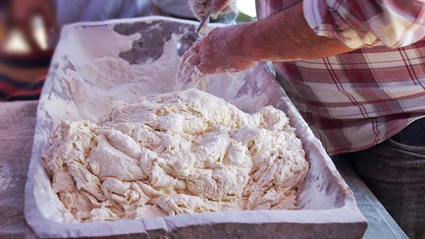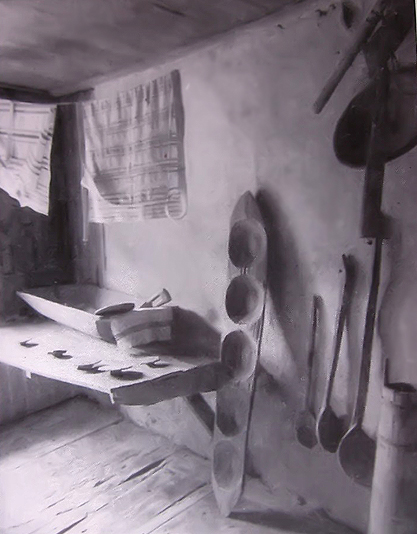Bread and wine are so pure that there is no evil to mar their sanctity. They are used for komka, or communion. Magic cannot affect bread and wine. We have to revisit these traditional notions every time we talk about a myriad of rituals in which bread and wine are paramount, as well as about the household ware used to make them. As present-day people strive to go back to nature and its gifts, an increasing number of enthusiasts today open the old books to learn how to knead the bread the way this was practiced in the Bulgarian lands for centuries. Now they have to discover a few new words and solve riddles such as: A side here, a side there with white snow in the middle. What is it? Well, of course, the trough.
Trough, noshtvi in Bulgarian is the wooden tray in which bread is kneaded. In the past, it was a must-have in every home, along with the hearth that was the first thing to build in a house. The trough was made of a whole piece of wood – either of elm or hornbeam. The elm was also used to delineate a new yard with a new fence. In traditional beliefs, a home encircled with an elm tree will never be deserted, because no evil can possibly pass by it. The hornbeam enjoyed special attention too. It is related to the myth of the Young God. In the days surrounding the winter solstice the Young God descended from heaven along the branches of a hornbeam. Legends and folk songs tell us that after the Holy Virgin gave birth to her Infant she looked for a tree in the woods to tie a cradle for Him. The only clean place found by her was a golden hornbeam.
 Just like all items linked to bread the trough was part of the women’s space in the house, but interestingly, was passed down from father to son. Once made and blessed, the trough would never leave the house. The old house is where the old trough is, a saying goes. The old house was where old couples lived, with the families of their grown-up children. If the father decided to separate his sons and build new homes for them, the young men had to make the troughs themselves for their wives to knead bread.
Just like all items linked to bread the trough was part of the women’s space in the house, but interestingly, was passed down from father to son. Once made and blessed, the trough would never leave the house. The old house is where the old trough is, a saying goes. The old house was where old couples lived, with the families of their grown-up children. If the father decided to separate his sons and build new homes for them, the young men had to make the troughs themselves for their wives to knead bread.
When entering a new home, the first thing for the man to do was to make fire in the hearth, and for the woman, to knead bread in the trough. Before that the wooden tray had been incensed and sprinkled over with virgin water. A similar sequence of actions was required in the process of integrating the young bride into the home of her in-laws. She was given a poker to stir the fire, then asked to go round the hearth three times and finally, was taken to the trough. There she had to leave gifts – bread, water and a cloth she had woven herself. Her mother-in-law then said to her, “Here, daughter, I give you the trough! Let it be full of dough for weddings and christenings, for various festive occasions!” At that point the bride bowed and kissed her mother-in-law’s hand.
 The trough was involved in various rituals for protection from evil eyes, from bad energy and thoughts, from strong fear and black magic. It was an important symbol in kneading the so-called Virgin Mary loaf of bread made when a child was born. The trough was also key to the ritual making of the patnina, the loaf made for a dead man to take away on his path to the next world.
The trough was involved in various rituals for protection from evil eyes, from bad energy and thoughts, from strong fear and black magic. It was an important symbol in kneading the so-called Virgin Mary loaf of bread made when a child was born. The trough was also key to the ritual making of the patnina, the loaf made for a dead man to take away on his path to the next world.
There is a plethora of bans surrounding the trough. One of them is not to let it stay uncovered. It should always be covered with a special round board on which bread is left to rest. Alternatively, the trough can be turned upside down, bottom up. If left uncovered the household would be threatened by ill luck. In the cases when the trough is open and ready for work, it is a bad omen if an animal jumps over it. This was a way to make the trough to weep and curse, meaning that the family should expect no good. In making new yeast, the young girl performing the ritual should not even glance at the trough. There older women had in advance put flour, water and secret herbs that the girl had to knead her back turned at the wooden tray.
The trough was a foremost symbol of the home’s prosperity. “Empty trough, hungry guests”, is one of the proverbs about it. And here is another one, “If you’ve got meek eyes, you’ve got an empty trough”, meaning, if you are too generous, you might fall into poverty. In folklore interpretations, dreaming a trough full of flour or dough is a good omen. If one dreams sifting flour in the trough this means that a dear guest will pay a visit to the house soon.
English version: Daniela Konstantinova
The Bulgarian village of Turia at the southern foothill of the Balkan Range is welcoming over a thousand participants in the Masquerade Games "Old Men in Turia". This year's edition of the festival on 30 March will feature 28 mummers' groups from all..
"In a vast region in northern Bulgaria, St. Todor is somehow perceived as a demonic character... He visited gatherings of unmarried girls, which were prohibited during that period; he acquired the appearance of a young bachelor, but distinguishable by..
Thousands of cowbells of different sizes and shapes filled the streets of Yambol with chiming, jingling and ringing at the 25th International Masquerade Festival "Kukerlandia". Згдшд More than two thousand mummers - called kukeri, sourvakari,..

+359 2 9336 661
